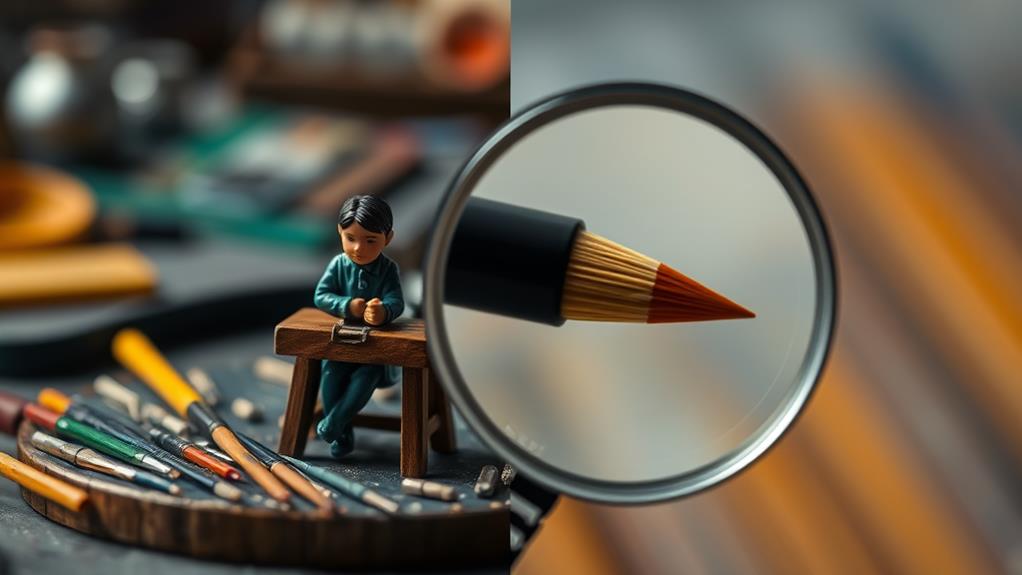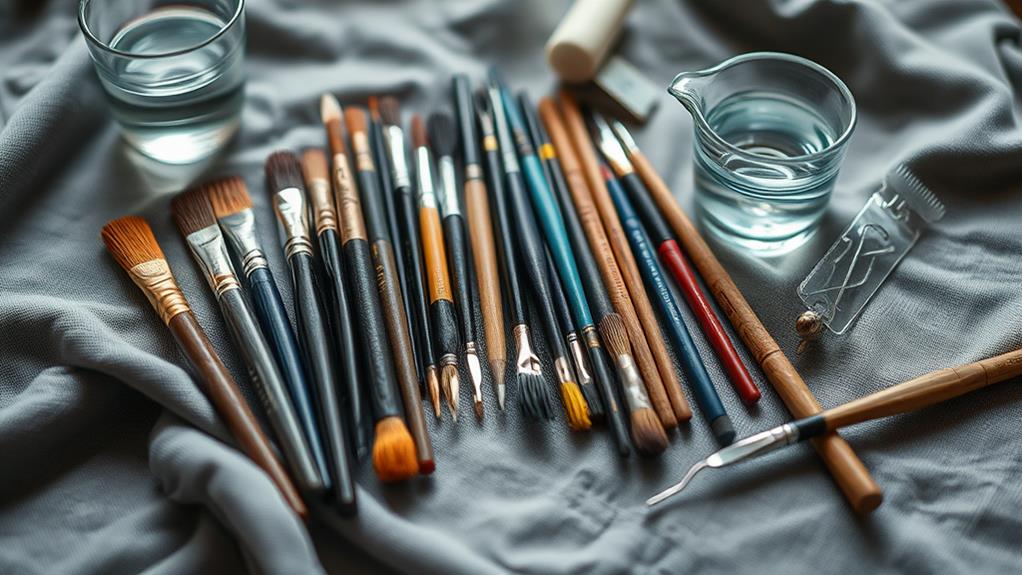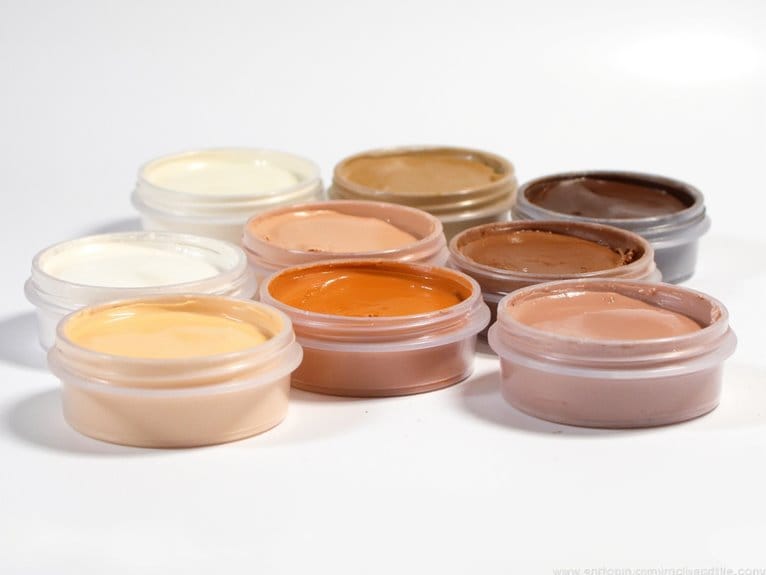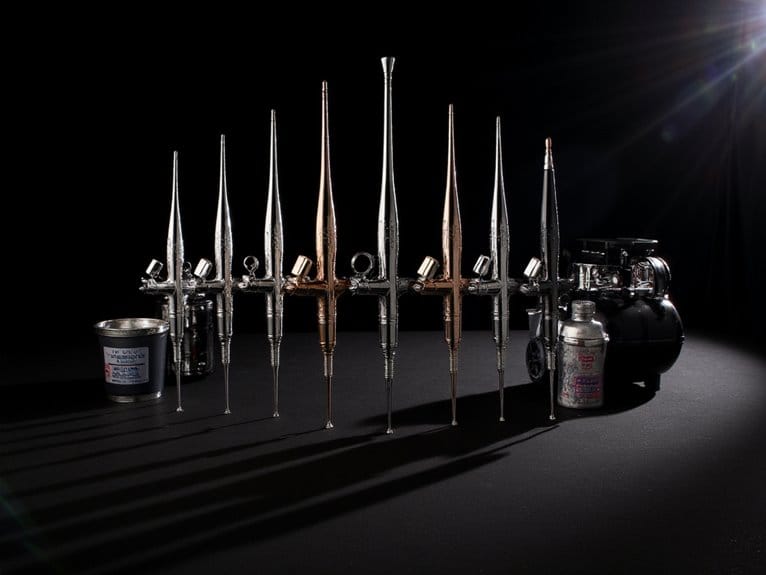We are supported by our audience. When you purchase through links on our site, we may earn an affiliate commission, at no extra cost for you. Learn more. Last update on 1st July 2025 / Images from Amazon Product Advertising API.
As you start your miniature painting adventure, you’ll quickly learn that having the right brushes is key to achieving mastery. You’ll need to decide between natural and synthetic brushes, each with their own strengths and weaknesses. Natural hair brushes offer superior quality and performance, but come at a higher price point, while synthetic brushes are more affordable and easier to clean. You’ll also need to choose the right brush size and shape for the task at hand, from fine details to broad strokes. And don’t forget to learn how to properly care for and maintain your brushes to get the most out of them – there’s more to discover ahead.
Introduction
When it pertains to painting miniatures and wargames models, having the right brush is vital. You can’t achieve miniature mastery without a good brush. It’s one of the beginner essentials that’ll make a huge difference in your painting fundamentals.
As you embark on your miniature painting journey, you’ll realize that brush selection is a pivotal aspect. It’s not just about slapping some paint on a model; it’s about precision, control, and finesse. A good brush investment will enhance your painting game, allowing you to achieve the intricate details and smooth shifts that’ll make your miniatures stand out.
But with so many options out there, it can be overwhelming. What makes a good brush? Should you go for natural hair or synthetic? What size and shape is best for you? Don’t worry; we’ve got you covered. In this article, we’ll delve into the world of miniature brushes, exploring the best options for you, from budget-friendly to high-end investments. Whether you’re a seasoned pro or just starting out, this guide will help you find the perfect brush for your miniature painting needs.
What Are the Different Types of Brushes?
In the realm of choosing the right brush for painting miniatures, you’ll encounter two main types: natural and synthetic. Natural hair brushes, like sable or kolinsky, offer superior quality and performance, but come at a higher price point. Synthetic brushes, on the other hand, are more affordable and easier to clean, but may not hold a point as well as their natural counterparts.
Natural vs. Synthetic Brushes
When choosing the right brush for painting miniatures, you’ll likely come across two main types: natural and synthetic. Natural brushes, made from animal hairs, excel at retaining water and paint, and holding a point longer, but they’re often more expensive and may not perform well with acrylic paints. Synthetic brushes, on the other hand, are less prone to damage, easier to clean, and more budget-friendly, but they might not hold a point as well as their natural counterparts.
What are the advantages and disadvantages of natural and synthetic brushes?
In the world of miniature painting, brushes are an essential tool, and choosing the right one can make all the difference. When deciding between natural and synthetic brushes, consider the pros and cons:
| Natural Brushes | Synthetic Brushes |
|---|---|
| Better paint-holding capacity | More durable and resistant to damage |
| Smoother application and blending | Easier to clean and maintain |
| Higher cost and maintenance requirements | Less expensive and versatile |
| Preferred for watercolors and oils | Suitable for various mediums |
| Better control and finer details | Good for beginners and casual use |
Ultimately, your brush choice depends on your artistic preference, budget, and painting style.
When should you use each type of brush material?
So, you’re wondering how to decide between natural and synthetic brushes for your miniature painting projects? It all comes down to the brush material and your specific needs. Natural choices, like Kolinsky sable, excel in paint absorption and holding a point, but are more delicate and pricey. Synthetic options are more durable, easier to clean, and affordable, but may not perform as well with certain paints. That being said, there are advantages of using synthetic brushes for certain applications. For example, if you are working with thicker paints or need to apply heavy layers, synthetic brushes may be more suitable for the job. Additionally, synthetic brushes are also a great choice for those who are concerned about animal welfare, as they are made from non-animal materials. Overall, the decision between natural and synthetic brushes ultimately depends on your painting style, preferences, and budget.
Different Brush Shapes
Brush shapes play a significant role in determining the effectiveness of a miniature painting brush. As regards painting miniatures, you’ll want to ponder the shape of your brush to achieve the desired results. Fine lines and detailed work require pointed tips, which are typically found in miniature and spotter brushes. These brushes have a sharp, tapered point that allows for precise control and delicate strokes. For larger areas and basecoats, you’ll want a brush with a longer hair length and a more rounded or flat shape. This will give you better brush control and the ability to cover more surface area. Tapered shapes are also useful for blending and smooth shifts. Ultimately, the shape of your brush will depend on the specific task at hand and your personal painting style. Experiment with different shapes and sizes to find what works best for you.
Choosing the Right Brush Size

When choosing a brush size, you’ll want to ponder the specific task at hand and the miniature’s size. Larger brushes (sizes 0-3) are ideal for painting large areas, while smaller brushes (sizes -1/0 to -10/0) are perfect for details. You’ll need to weigh to find the right size for your painting style and the miniatures you’re working with.
Understanding Sizes and Their Uses
As you excavate into the world of miniature painting, you’ll quickly realize that understanding brush sizes is essential for achieving the desired results. Brush size importance cannot be overstated, as it directly impacts the quality of your work. When selecting a brush, consider the task at hand and the desired outcome. For example, smaller brushes (00, 0, and 1) are ideal for details, while larger brushes (2 and up) are better suited for basecoats.
Brush shape significance is also pivotal, with round brushes being the most versatile and widely used shape for miniature painting. Flat brushes are useful for applying washes and drybrushing, while filbert brushes excel at blending and highlighting. Liner brushes are designed for painting thin lines, such as details on weapons or armor.
When it comes to miniature painting essentials, having the right brush size and shape is paramount. Brush selection tips include considering the size and shape of the brush, as well as the material it’s made of. Brush measurement variations can be confusing, so be sure to check the measurements carefully when trying a new brand. By understanding brush sizes and their uses, you’ll be well on your way to achieving stunning results in your miniature painting endeavors.
When should you use each brush shape?
You’ve got a solid grasp of brush sizes and their uses, but now it’s time to take it a step further by exploring the specific scenarios where each brush shape shines. Understanding when to use each brush shape can substantially improve your painting skills and results.
- Round brushes: Ideal for general painting, blending, and details, providing excellent brush stroke control and paint flow management.
- Flat brushes: Perfect for applying washes, drybrushing, and creating straight lines or sharp edges, allowing for precise brush angle technique.
- Filbert brushes: Great for blending, highlighting, and creating soft changes between colors, offering superb color blending tips.
- Liner brushes: Designed for painting thin lines, such as details on weapons, armor, or text, providing precise stroke direction guidance.
- Decorator’s brushes: Useful for basecoating and applying thick textures, offering versatility in brush stroke control and paint flow management.
Which Brands and Models Are Recommended for Miniature Painting?
When it comes to selecting the best brushes for miniature painting, you’ll want to weigh top brands and models that cater to your specific needs. Artis Opus is a popular choice among miniature painters, offering artist-grade brushes tailored specifically for this niche. You’ll also want to examine other recommended brands, such as Windsor & Newton, Rosemary & Co, Games Workshop, and The Army Painter, each offering unique features and benefits.
Artis Opus: Best Brand for Miniatures – Artis Opus Series S, M, and D Ranges
Among the top-tier miniature painting brushes, Artis Opus stands out as a brand that has garnered a loyal following among serious hobbyists. Their Series S, M, and D ranges cater to different painting styles and preferences, offering unique features that set them apart from traditional brushes.
When it comes to the Brush Quality Debate, Artis Opus brushes are often praised for their exceptional performance and durability. The ergonomic handles provide a comfortable grip, making them ideal for extended painting sessions.
Here are some key benefits of Artis Opus brushes:
- Drybrush Performance: The Series D drybrushes are renowned for their ability to achieve textured effects on miniatures.
- High End Investment: While the price point is higher than many competitors, the quality and performance of Artis Opus brushes make them a worthwhile investment for serious hobbyists.
- Brush Durability Myth: Contrary to the myth that high-end brushes are fragile, Artis Opus brushes are known for their durability and ability to maintain their shape and effectiveness over time.
- Versatility: The Series M brush set is versatile and caters to both beginners and experienced painters.
- Aesthetic Design: The brushes are designed to provide an enjoyable painting experience, with users appreciating the aesthetic design that adds to the overall experience.
Windsor & Newton Series 7
Windsor & Newton Series 7 brushes have long been a staple in the miniature painting community, and for good reason. These high-quality brushes are favored by many professional miniature painters, including the Games Workshop ‘Eavy Metal team, who swear by them for fine line and freehand work. The Series 7 brushes are handmade with Kolinsky sable hair, renowned for their exceptional brush durability and hair quality. As an artist, you’ll appreciate the way these brushes hold their shape and maintain their performance even with rough treatment. However, it’s essential to note that Windsor & Newton offers both standard and miniature versions of their Series 7 brushes, with the latter being preferred by many miniature painters. Your painting style and artist preference will ultimately dictate which brush is best for you. If you’re looking for a brush that will last, Windsor & Newton Series 7 brushes are a great investment, but don’t forget to properly clean and condition them to maintain their brush longevity.
Rosemary & Co: Budget-Friendly Options
Your search for high-quality, budget-friendly brushes for miniature painting ends with Rosemary & Co, a UK-based company that has been serving artists worldwide for 25 years. They offer a wide range of high-quality brushes at affordable prices, making them an excellent option for miniature model painting enthusiasts on a budget.
Here are some key benefits of choosing Rosemary & Co brushes:
- Affordable prices: Rosemary & Co brushes are 50-60% less expensive than similar quality brushes from other brands.
- High-quality fibers: Rosemary & Co uses Pure Kolinsky Sable fibers in their Series 33 and Series 22 brushes, and Pure Red Sable fibers in their Series 99 brushes.
- Wide range of sizes: The Series 33 is available in sizes #24 to #10/0, and the Series 22 is available in sizes #20 to #0.
- Short and long handle options: The Series 33 comes in both short and long handle options to suit your personal preference.
- Ideal for beginners and hobbyists: Rosemary & Co brushes are perfect for miniature model painting enthusiasts who want high-quality brushes without breaking the bank.
Rosemary & Co’s commitment to using high-quality fibers and manufacturing their brushes in-house allows them to offer exceptional brush quality at a budget-friendly price.
Games Workshop Brushes for Beginners
When you’re just starting out with miniature painting, it can be overwhelming to choose the right brushes for your models. Games Workshop brushes are a great option for beginners, offering a more affordable entry point into the world of miniature painting. Their new STC Paint Brushes are fully synthetic, making them a cruelty-free option for those who prefer not to use animal hair. These brushes are designed to be more durable and resistant to wear, with stiffer bristles that maintain their shape well. They’re particularly effective for base coating and layering, especially with difficult paints like Contrast and Metallics. While they may not offer the same level of precision as higher-end brushes, they’re a great option for beginners who need reliable tools. The synthetic quality of these brushes also makes them easier to clean and maintain. With their affordable price point and accessibility, Games Workshop brushes are a great choice for those just starting out with miniature painting.
The Army Painter’s Wargamer Series
As you plunge into the world of miniature painting, you’ll likely come across The Army Painter’s Wargamer Series, which offers a unique blend of quality and affordability.
This series is particularly notable for its Wargamer Balance, offering a range of brushes that cater to different painting styles and needs. One of the standout features of these brushes is their Brush Durability, ensuring that they’ll withstand the rigors of frequent use.
The Army Painter’s Wargamer Series provides:
- Painting Control: The unique brush shapes provide excellent control, allowing you to achieve fine details and smooth blends.
- Model Details: The fine tips and flexible bristles make it easy to paint intricate model details without sacrificing precision.
- Fine Lines: The Wargamer Series excels at creating fine lines and delicate details, making it an excellent choice for miniature painters.
- Affordability: The Army Painter’s Wargamer Series offers an excellent balance of quality and price, making it an accessible option for painters of all levels.
- Variety: The series includes a range of brush sizes and shapes, catering to different painting techniques and styles.
Da Vinci Maestro Series
Da Vinci’s Maestro Series brushes have earned a reputation for delivering exceptional quality and performance, making them a popular choice among miniature painters. The Micro Maestro, in particular, is a standout for its exceptional brush quality and precision. With its long, thin handle, you’ll have the control and precision you need to paint small details on models and miniatures. The synthetic bristles hold their shape well, providing a smooth, even application of paint. You’ll appreciate the firm yet flexible bristles that allow for both precise detail work and broader strokes.
The Micro Maestro is ideal for painting small details like facial features, insignia, and other small elements on miniatures. Its sharp, precise point makes it perfect for intricate details and clean lines. With its durability and ease of cleaning, this brush is a worthwhile investment for serious miniature painters. Whether you’re a beginner or an experienced painter, the Da Vinci Micro Maestro Series 100 is an elite brush that will help you achieve miniature mastery and deliver exceptional detail dynamics.
BrokenToad Miniature Mk3
You’ve likely pondered Da Vinci’s Maestro Series, but now you’re looking for an alternative that’s specifically designed for miniature painting. That’s where the BrokenToad Miniature Mk3 comes in – a premium brush range tailored to help you achieve miniature mastery.
The Mk III features high-quality synthetic fibers that mimic natural hair, providing excellent paint retention and smooth application. These premium options are designed to withstand extensive use without losing shape, making them a worthwhile investment for serious miniature painters.
Key benefits to ponder include:
- Ergonomically designed handles for comfortable grip during long painting sessions
- Suitable for a variety of painting techniques, including fine details and broad strokes
- Easy to clean with proper care, maintaining the longevity of the brushes
- Attractive design that appeals to collectors and enthusiasts
- Capable of achieving fine details, making them suitable for intricate work
With their synthetic superiority, the BrokenToad Miniature Mk3 brushes offer a unique blend of quality, performance, and durability. If you’re looking for a premium brush range that’s specifically designed for miniature painting, these brushes are definitely worth pondering.
Monument Hobbies Bomb Wick Det. Cord
With Monument Hobbies’ Bomb Wick Det. Cord, you’ll experience miniature mastery like never before. This brush set is designed specifically for painting miniatures, offering brush excellence and precision. The synthetic fibers provide good paint retention and smooth application, making it ideal for fine details and intricate designs.
| Brush Size | Recommended Use |
|---|---|
| 0/0 | Fine details and small areas |
| 1/0 | Medium details and general painting |
| 2/0 | Basecoats and large areas |
| 3/0 | Drybrushing and texture work |
| 4/0 | Heavy washes and thick paints |
The ergonomic handle guarantees comfort during extended painting sessions, and the brush’s ability to maintain its shape reduces the need for frequent replacements. As a hobby essential, the Bomb Wick Det. Cord is an affordable option compared to other high-end brushes. While it may not perform as well with thicker paints or heavy-bodied mediums, proper care and maintenance will confirm its lifespan. For serious miniature painters, the Bomb Wick Det. Cord is a worthwhile investment for achieving detail dominance and miniature mastery.
How Should You Care for and Maintain Your Brushes?
As you start painting miniatures, it’s essential to develop good habits for maintaining your brushes. You’ll need to clean them regularly, using techniques that suit the type of paint you’re using, to prevent damage and extend their lifespan. By storing them properly and taking care of them, you’ll guarantee your brushes continue to perform well and provide the best results for your miniature paintings. Also, make sure to reshape the bristles after cleaning and allow them to dry completely before storing them. This will help maintain the original shape of the brush and prevent any unwanted fraying or splaying of the bristles. Preserving paint brush quality is not only important for the longevity of your tools, but it also ensures a more precise and controlled application of paint for your miniatures. By making these habits a regular part of your painting routine, you’ll be able to consistently achieve high-quality results.
Most miniature painters invest a significant amount of time and money into their brushes, but often overlook a crucial aspect of their longevity: proper maintenance and care.
To guarantee your brushes last a long time and perform well, it’s essential to develop good habits.
- Clean your brushes frequently, never allowing paint to dry in the bristles. This will prevent paint damage and extend the brush lifespan.
- Store your brushes upright to protect their shape and prevent warping.
- Avoid cleaning brushes too roughly, which can alter their original shape and affect their performance.
- Use the appropriate cleaning method based on the paint medium used, such as water for watercolor and gouache, and solvents and brush cleaners for acrylic and oil-based paints.
- Regularly inspect your brushes for hardened paint near the roots, and carefully work it out to maintain the brush’s shape and performance.
What Are the Best Cleaning Techniques?
You’ve invested in a quality set of brushes, and now it’s time to learn how to take care of them. Proper brush care is essential for maintaining their performance and longevity. Clean your brushes after every painting session using cool or lukewarm water. For regular cleaning, use a dedicated brush soap, working up a lather and gently rubbing it into the bristles. Rinse the soap off thoroughly with cold water to guarantee no residues remain. Reshape the bristles into a fine point before drying to maintain their form.
When it comes to water temperature, stick to cool or lukewarm water to prevent damage to the bristles. For drying, place your brushes vertically with bristles facing down or horizontally on a brush rest. Perform a deeper clean weekly or after every 3-4 hours of painting using a liquid brush restorer to remove deeper paint residues. Regular maintenance routines, such as changing rinse water frequently and using a brush conditioner, can save you money by prolonging the life of your brushes. By following these brush cleaning methods and techniques, you’ll be able to keep your brushes in top condition and certify they remain in optimal shape.
How Should You Store Your Brushes?
Proper storage is crucial to maintaining the quality and longevity of your paint brushes. To safeguard your brushes remain in top condition, it’s essential to store them correctly.
- Store your brushes in an upright position to prevent the bristles from becoming bent or damaged.
- Invest in brush holders or protective cases that keep your brushes organized and protected from dust and debris.
- Consider using brush stands that allow you to store your brushes with the bristles facing down, keeping them clean and dry.
- Avoid storing your brushes in a crowded or cramped space, as this can cause them to become tangled or damaged.
- Keep your brushes away from direct sunlight and extreme temperatures, which can cause the glue to weaken and the bristles to become brittle.
When Should You Invest in Higher-End Brushes?
Frequently, miniature painters wonder when to take the leap and invest in higher-end brushes. The answer lies in your painting journey and personal goals. Consider upgrading your brushes when you’ve reached a certain painting milestone, such as completing 20 models or achieving a specific skill level. This indicates you’re committed to improving your craft and willing to invest in quality tools. Budget constraints are also a vital factor; if you’re serious about miniature painting, it’s worth allocating a larger portion of your budget to high-end brushes.
Ultimately, the decision to upgrade depends on your personal preference and priorities. If you’re satisfied with your current brushes and don’t see a need for better performance, there’s no need to invest. However, if you’re seeking improved control, precision, and durability, higher-end brushes can make a significant difference. Take the time to assess your needs and goals before making the investment.
What Are Common Mistakes to Avoid When Choosing and Using Brushes?
In regards to choosing and using brushes for painting miniatures, you’ll want to steer clear of some common pitfalls that can hinder your progress. You might fall victim to “cheap brush syndrome,” where you’re tempted to settle for low-quality brushes that won’t deliver the results you want. By being aware of these mistakes, you can avoid wasting time and money, and instead, focus on finding the right brushes that will help you take your miniature painting skills to the next level.
Cheap Brush Syndrome
One of the most common pitfalls for miniature painters is falling victim to “Cheap Brush Syndrome.” You might think you’re saving money by opting for cheap alternatives, but in reality, you’re setting yourself up for painting frustrations and mediocre results.
Here’s what happens when you choose brushes based on budget limitations rather than quality:
- You’ll struggle to achieve smooth, even coats, leading to a subpar finish.
- The bristles will wear out quickly, forcing you to replace them often.
- You’ll experience inconsistent performance, making it difficult to achieve the results you want.
- Cheap brushes often have poor spring and snap, making it hard to control the paint.
- You’ll waste time and money in the long run, as you’ll need to replace cheap brushes frequently.
Don’t fall into the trap of Cheap Brush Syndrome. Invest in quality brushes that meet your painting needs, and you’ll be rewarded with better results and a more enjoyable painting experience.
Wrong Brush Size
You’ve likely encountered the frustration of using the wrong brush size, only to struggle with achieving the desired results in your miniature painting. This common mistake can lead to painting frustration, wasted time, and a lack of detail in your miniature’s features. When choosing a brush, it’s essential to ponder the specific miniature details you want to achieve. A brush that’s too large will struggle to reach small areas, while a brush that’s too small will lack the coverage you need for larger surfaces.
To avoid this mistake, ponder your brush expectations and the specific tasks you need the brush to perform. If you’re working on fine details, a smaller brush size (0 or 1) is usually ideal. For larger areas, a size 2 or 3 brush is more suitable. Remember, brush quality also plays a significant role in achieving the desired results. A high-quality brush will retain its shape, hold a point, and provide the necessary spring and snap to achieve precise control. By selecting the right brush size and quality, you’ll be well on your way to achieving professional-looking results in your miniature painting.
Poor Brush Care
Neglect can be a silent killer of your miniature painting brushes, leading to a shortened lifespan and subpar performance. You might not even realize you’re making mistakes that can ruin your brushes.
To avoid Brush Wear and Damaged Bristles, make sure to:
- Avoid using harsh Cleaning Products that can strip your brushes of their natural oils, leading to Brush Ruin.
- Don’t leave paint on your brushes for extended periods, as it can cause Paint Damage and affect their performance.
- Store your brushes properly, away from direct sunlight and moisture, to prevent them from becoming brittle or warped.
- Clean your brushes regularly, using gentle soap and water, to remove dirt and debris that can accumulate and cause damage.
- Handle your brushes with care, avoiding excessive bending or twisting, which can cause the bristles to become misshapen or break.
Incorrect Brush Use
In terms of painting miniatures, your brush is an extension of your hand, and improper use can lead to subpar results and even damage your tools. One of the most common mistakes is incorrect brush grips, where you hold the brush too tightly or at an awkward angle, causing the bristles to splay or become uneven. Brush mishandling can also occur when you’re not gentle when handling your brushes, leading to bent or damaged bristles. Paint buildups are another issue, where you don’t clean your brush properly, causing paint to dry on the bristles and affecting their performance. Overused bristles are a result of using your brush for too long, causing them to become frayed and worn out. Finally, cleaning mistakes can happen when you use harsh chemicals or rough cloths to clean your brushes, stripping them of their natural oils and causing damage. By avoiding these common mistakes, you can guarantee that your brushes last longer and perform at their best.
Brush Overreliance
Beyond the domain of incorrect brush use lies another pitfall: brush overreliance. You might think that investing in the most expensive, high-quality brushes will guarantee exceptional painting skills, but that’s not entirely true. Brush overreliance can lead to quality obsession, where you focus too much on the tools and not enough on developing your skills.
This can result in tool dependency, where you feel like you can’t paint without a specific brush. Additionally, when that brush doesn’t perform as expected, you might experience painting frustration. Remember, a good brush is only as good as the painter using it.
Some common signs of brush overreliance include:
- Believing that a specific brush is the only one that can achieve a certain effect
- Feeling like you can’t paint without a particular brush
- Spending too much money on high-end brushes without seeing significant improvements in your skill
- Focusing more on the brand or quality of the brush than on your actual painting technique
- Thinking that a good brush will automatically make you a better painter, without putting in the necessary practice and effort
Conclusion
Wrapping up your search for the perfect miniature painting brushes, you’ve likely discovered that the best brush for you depends on a multitude of factors, including your painting style, budget, and personal preferences. As you’ve read through this guide, you’ve learned that Brush Selection is a vital part of your Painting Experience. You’ve seen that Quality Matters, and investing in high-grade brushes can enhance your work. Your Brush Evolution will be unique, shaped by your individual needs and preferences.
Brush Maintenance and Care Essentials

You’ve chosen your perfect miniature painting brushes, now it’s time to guarantee they remain your trusted companions for a long time. Proper brush maintenance and care are vital to extend their lifespan and guarantee peak performance.
- Brush cleaning tips: Clean your brushes gently with soap and water, and condition them regularly to prevent damage.
- Brush storage methods: Store your brushes in a protective case or roll to prevent bending or crushing.
- Brush durability tests: Test your brushes regularly to identify any signs of wear and tear.
- Brush care routines: Establish a regular cleaning and maintenance schedule to keep your brushes in top condition.
- Brush maintenance schedules: Set reminders to clean and condition your brushes after each use, and perform deeper cleaning every 1-2 weeks.




